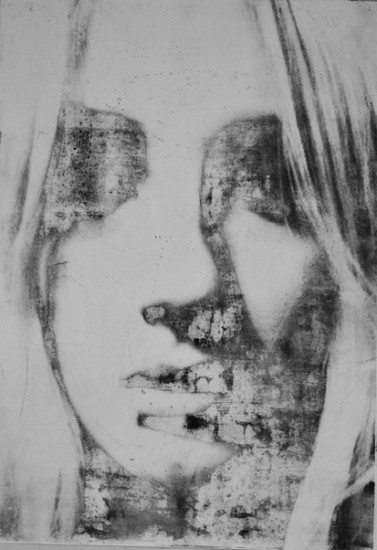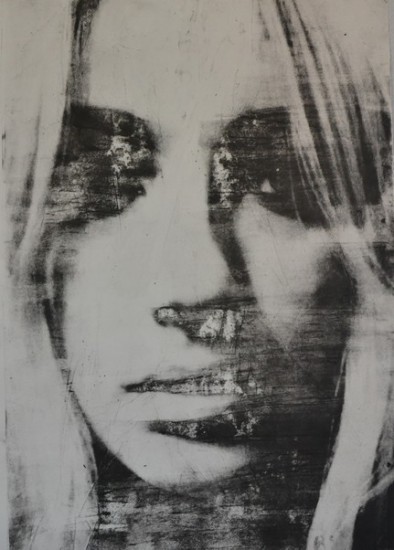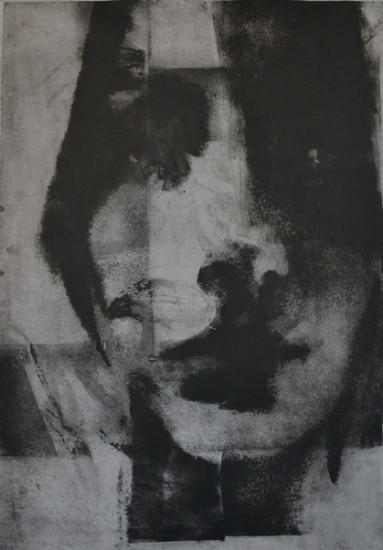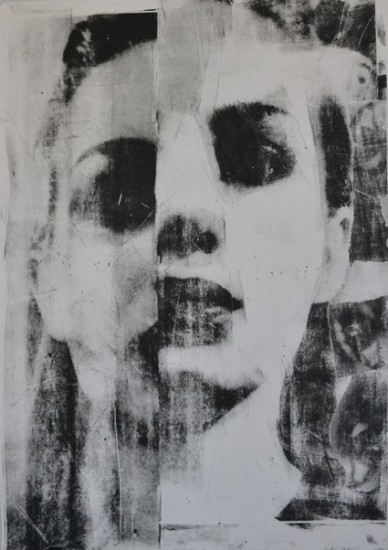Oktawia Furtak Self-portraits
supervisor:
prof. Henryk Ożóg
Academy of Fine Arts in Krakow
Faculty of Graphics
Faculty of Graphics
biography
[biography not available]
Selfportraits can be defined as an artistic expression of our superficiality, as well a way to express our inner depth. It is a kind of a selfresearch. A process while which we carefully and thoroughly study our appearance, mimics, gestures, it allows as to better interpret ourselves. It is not however unambiguous, because many questions might arose while creating.
The author's attitude towards himself is completely different than other subjects of the portrayal. It is a matter of our personality. We have a different approach of examining ourselves than other people. We experience oneself though our feelings, thoughts and emotions. Our selfportrayal is never perfect because we already have an inner knowledge about ourselves.
One of the main inspiration for creating selfportraits is the need of better comprehension of oneself, an urge to get into one's depth. We discover ourselves not only through introspection, but also through extrospection like the analysis our face mimics or behavior. What is a selfportait than? When I examine an artist work I have a feeling that a painter shares with us only an idea about one's representation. Very often an author wears a kind of masc, or creates a different version of oneself.
Our superficiality is very significant. By our appearance we interact with the outer world. In an interpersonal contact, the looks is often a first element of an interaction. It can also fundamentally influence our lives on many levels. Our vision of ourselves can be various and often contrasting. There are few types of our selfawareness: narcissist, hateful, scornful, humorous, or heroic.
A narcissist type centers himself and his appearance on the top of everything. Very often such a person has kind of obsession about one’s looks and like to admire oneself constantly. A narcissist likes to be perceived and adored by it’s outwardness. A narcissist individual has a big ego and selfesteem. In art history we can observe such idealisation of one’s appearance by many artist. As an example we can see the selfportait of such artist like: Durer, Van Dyck, Rembrandt, Malczewskiego or Wyspiańskiego. These painters did not resemble their actual looks, but rather their imagination about themselves or how they wanted to be perceived. By idealizing their appearance they wanted to create themselves as bettersuited, more noble or simply richier than in reality. For example young Rembrandt was portraying himself as an army officer, Gottlieb as a nobleman, or Velazquez as a knight. The most common aspect of this “idealisation” is either one’s beauty, elegance or social status. Nikifor for example, was uneducated peasant, who cannot write or read. He was often ridiculed and obscured by others. His way to give himself some esteem was an artistic transformation into other personality. In his works he often portrays himself as a noble man, teacher or priest.
Contrary to this approach we can establish a hateful or scornful type of selfawareness. A person like that is obsessed with it’s own ugliness, which is very often fictitious. Feels that is harmed by nature and is being rejected by others. Is also characterized by a very low selfesteem, it’s own inferiority which can lead to being disdained by himself. We can observe such selfreluctance in Egon Schiele works. The artist portrays himself very unfavorably or even grotesque. His body is often crooked and viewed in unnatural poses. When reviewing his works I’m experiencing anxiety or sometimes even disgust. Nevertheless this another approach is also very selfcentered, but contrary to narcissistic impulses is driven by more introvert needs and some impossible pursuit for being perfect and beautiful.
As a completely different type of personality, because not so selfcentered, we can distinguish humorous approach. A humorous person is aware about it’s flaws or imperfections, as well as its’ advantages and merits. Such a character can easily value itself from the distance. It’s not trying artificially to enhance its’ imperfections. We can even say that such a person has a way to turn their flaws into merits. The personal defects do not overwhelm such a person, but can even make him laugh. Therefore artists with such approach very often create their own caricatures. Grottger, for example, who was suffering from ongoing tuberculosis was constantly losing on his weight. In his works he viewed himself as terribly thin or, in advance stadium of his illness, as a puppet. When viewing works by Kossak, we can have an impression that he was purposely highlighting his baldness and laughing of his obesity.
The heroic personality is characterized mostly by the awareness of one's own imperfections, weaknesses, illness or senility. A person like this accepts his own situation with pride and no regrets. can come to terms with reality The Wyspianski selfportrait, which was made couple of months before his departure, views his face as destroyed and deformed, it looks like the illness has taken it’s toll on him. Rembrandt on one of his sketches pictures himself as a hunched person with a toothless head. Another example is Van Gogha. The artist though his works shows us the process of his mental deterioration and gradual fall into madness. His face is sunken and his eyes crossed. One of his most famous and drastic depictures is a portrait with a head covered in bandages, because the artist in his attack on insanity cut off his own ear. In this instance, what is quite shocking is the realism of the selfexpression.
It’s impressive how the author portrayed himself almost literally.
The painters always enjoyed the art of selfportrait. Very often the reason behind this is the
need to be admired by others, or a way to express their flaws and weakness. It can be either humorous with a large dose of selfdistance, or extremely realistic. Either way, it is always a way for the artist to take an insight into oneself, not only superficially. Alike mythological Narcissus who observes his reflection and fells in love in it, the artist self portrait is never complete. He confronts something that prevents him from selfidentification, from
understanding himself. Such vainness is part of our nature and it is encoded in ourselves. We are the autonomous source of cognition a very center of the world.
Our lives experiences and feelings that are connoted by the memories are always the most meaningful for us. They can directly influence our personality. Each of us has their very own, specific set of memories and history. The interpretation of a reality is therefore a subjective process. Every person has an insight into content that is unavailable for others. Concluding I believe that focusing on oneself and our own dreams and desires is a natural and health
expression of our “I”. While reading a book we often wonder, how many of the events depicted are fictional, and how many were really experienced by an author. In many cases the novel’s plot is based on author biography. Other incentives affecting the author may also influence one’s imagination. Mexican painter Frida Kahlo, when asked about why she was concentrating on herself in her works replied “I create selfportraits because very often I’m
alone, because I’m a subject which I know the best”.
I have taken working on selfportraits believing that this may be an important experience for me. Crucial was a need to explore myself better and perhaps discovering something new. Another factor was to uncover how I really imagine myself. After a period of time spent on working on these works, and trying to deeply analyze myself I have gained both courage and doubts at the same time. At the beginning I had difficulties with creating my image. I believe
that it was a fear of more bold way of selfexposing. The first attempts were not completely free. The awareness of my selfreflections
was to be judged by others was a major drawback of my artistic expression. I have encounter many questions, why do I perceive some external
characteristics as disadvantages? Am I alike others, a part of some broad criteria of aesthetic beauty? I am also try to fit into those standards, even by means of harming myself? Does thoughtless pursue for the “perfect” engraves an inferiority complex in our minds? Is it worth to go in a direction just to think little more of oneself and become alike someone or something that has no meaning for us? I believe we lost our way to truly improve ourselves minding the things of a little importance. We should get rid of the limits we put on ourselves.
After some period of work I had finally overcome this stereotypical approach towards selfportrait. While studying my mimics or well being, each time I can look differently and deeper inside me. With each selfportrait I can see myself anew. My image doesn’t have to be “pretty” and thus neuter. I’m more focused on exploring and exposing my individual aspects. This theme of work is of greater importance for an artist rather than the spectator.
Art art process has been extremely selfdiscovering for me because of what I choose to show and hide before viewer. I had learner of which aspects I am proud, and of which I’m rather ashamed, which I had not known before. The effects were surprising especially how I subconsciously perceive myself. The process of creating the work is very enriching.
Our reflection in a mirror appears to be an ideal copy of ours. This is the most obvious and realistic way to observe ourselves. However the image reflected and imagined by me is simultaneously created and destroyed by the very same imagination. The reflection in the mirror therefore cannot be foundation to create one’s identity, it can only be a sort of hint. The work on selfportrait has taught me, that the image that is created is the result of a hidden mind’s work. I explore new characteristics, or even behaviors that directly influence my work on selfportrait. What is superficial and suppose to be most visible became unclear, while what is hidden, emotional became visible. I had also gained some sense of courage during the art process. For my series of works I have used the Intaglio technique. It gave me a wide range of means to work on a subject. My graphics were primarily created using aquatint. For enriching the image I had also used other methods (including photography), which allowed me to achieve a desired effects. I have used photography as a mirror a raw image taken and put directly onto paper. Working on graphics is often surprising, because it can bring many unexpected or accidental features. I have treat it however as an additional value gained to my works. While working on a series of selfportraits I have learned that taking attempts to selfidentification is a constant process which ceases only with the end of our existence, because every event and experience in our lives makes an impact on who we are. It is difficult for us fully determine ourselves. We often can have a contrary feelings about oneself, moral codes and the beliefs of what is right, what is wrong and what is really meaningful. We are changing every day, or even every second biologically speaking. Our incapability to achieve the full understanding of oneself is therefore the very meaning of this experience.













